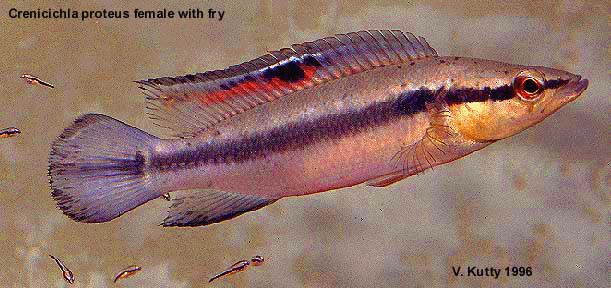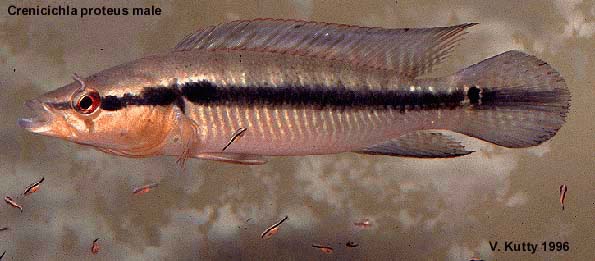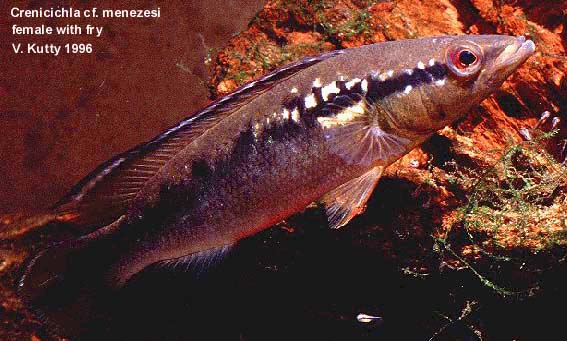
|
| Crenicichla proteus and C. cf. menezesi - A Tale of Two Pikes |
|---|
By V. Kutty
| This article deals with husbandry and captive reproduction of the Peruvian Crenicichla proteus and East Brazilian C. menezesi, representatives of the saxatilis-group pikes. |
After about 5 years of keeping most of the regularly encountered Pike cichlid species, I started getting frustrated at the lack of availability of many of the Pikes I d read about in scientific journals and some European aquarium magazines. I knew very few people who actively kept these fish. Sure, there were many who were interested and a few of them actually kept a species or two, but they were not hardcore Pike nuts.
Crenicichla proteus Cope, 1872
Luckily, a dear friend, Joakim Coveney happened to be an importer of African cichlids from Europe. I'd bug him frequently about getting me some Pikes from Europe. Finally, he was able to track down some Crenicichla proteus.

They were shipped from Amsterdam and when they arrived in Tampa, the water temperature was 60°F! There were about 10 little gray Pikes, alive but regretting it. I didn t think they d make it, but I introduced them into a 55-gal tank containing a lot of driftwood and rocks; they weren t happy. After 2 days, they were still alive and curious. I couldn t tell any differences among the sexes but then again, they were only 1-2 inches long. Fortunately for me, they were quite used to eating pellets and prepared foods. They quickly established a hierarchy among themselves but left their other larger tankmates alone.
PIKE CICHLIDS |
They are members of the saxatilis-group, consisting of about 28 described and about half as many undescribed fish. |

They are often collectively called Spangled Pikes for their attractive spangling on the flanks of most males and some females. Extreme spangling is a trait found in many coastal saxatilines, such as C. saxatilis itself, where even the females are often highly spangled. C. frenata Gill, 1858 from coastal Venezuela and Trinidad is another Pike with numerous spangles. Our three species are not as spangled as the coastal forms, with C. anthurus males having the most spangles while C. lucius and C. proteus sport almost no spangles. The three are moderately sized, growing to about 8 to 10 inches TL and are mellower in temperament than some of the larger, coastal cousins. A fourth species C. semicincta Steindachner, 1892 may have to be added to this group as more knowledge becomes available but this species has an uncommon marking for a saxatiline - a suborbital stripe or a thin, slanted line below the eye, leading to the cheek.
PIKE CICHLIDS |
Most saxatilis-type fish have what is called a suborbital triangle or blotch, which is often red or black in color. |
Synonyms for C. proteus include C. proteus var. argynnis Cope, 1872 and Batrachops nemopterus Fowler, 1940. Cope described C. proteus from specimens collected in Rio Ambiyacu. This species occurs in Rio Napo, upper Rio Putumayo, Rio Pachitea, Rio Aquaytia, Rio Oroso and Rio Ucayali drainage, in slower moving waterways, riverside lakes and pools with abundant aquatic and shoreline vegetation. Pettersen and Wolla (1997) report finding the fish in black, white and clear water habitats, with a pH range of 4.5 to 8.2 a variation that they attribute to heavy rainfall at the upper reaches of the rivers. They report finding the fish in creeks with sunken branches and leaf litter.
PIKE CICHLIDS |
Stomach contents of wild fish revealed insects, insect larvae, molluscs, shrimp, fish eggs and fish. |
The aquarium behavior of this Pike is similar to a lot of other Saxatilis-type Pikes, perhaps a bit more reserved than others but the company they keep has a lot to do with how much physical damage they may inflict on their tankmates. I generally kept this fish with larger, more assertive fish, so I did not lose other fish from aggression. Of course, males were very aggressive towards each other from a fairly early stage, so it became quite apparent who was going to rule the roost and breed with the available females. The dominant male eats more than the others and consequently gets bigger and more assertive. Within a few months, the 10 little gray Pikes I bought grew into males and females, with roughly equal number of sexes. The females began to develop the reddish colors and the dorsal ocelli, while the males just got bigger.
I'd added about 25 Black Neon tetras (Hyphessobrycon herbertaxelrodi) donated to me by a Florida fish farmer, to the tank as a graduation present for growing up. Soon, the tetras were disappearing. I had to remove the Biotodoma cupido from the tank to save their lives. By the time the males were 4-5 inches, their numbers were down to 7 and I began losing a fish a month to aggression. I still had a swaggering male, a couple of females and a few runts who wished they were dead. A typical cichlid scenario - I didn't panic. Still, I didn't think they were too aggressive. Aggression is when you can't keep two fish of the same species in a tank, regardless of the size of the tank. I had PVC tubes scattered around the tank generously, besides a lot of driftwood and rocks. There was plenty of cover.
I also had a few micropredators in the tank - the characin Crenuchus spilurus. These are not ideal inhabitants of Pike cichlid tanks, since they are only about 2-3 inches in length. These characins had been in the tank prior to the introduction of the Pikes, so there they stayed. These tetras are largely immobile, ambush predators of small fish and insects. They were only slightly larger than the Black Neon Tetras that were in the tank and would have made a convenient mouthful for any of the Pikes in the tank, but the Pikes did not eat any of the Crenuchus! After the Pikes paired up, they began instead, to harass the Crenuchus like they did the other cichlids in the tank.
Even after all the Black Neons were consumed, the Crenuchus remained. I eventually began scooping out thrashed and destroyed Crenuchus out of the water. The Pikes were killing, rather than eating these small tetras. I'll never know why this happened but my thoughts are that these Pikes instinctively recognized the anatomy of this tetra as belonging to a potential predator of their offspring. Could it be because Crenuchus resembles a dwarf cichlid? After all, it does not possess the generalized characoid shape of say an Astyanax. Gery (1977) reports that this tetra spawns on surfaces of leaves, much like cichlids. I realize such anecdotal evidence doesn't prove anything concrete but it sure reminds me why I love cichlids.
PIKE CICHLIDS |
Fleeting glances, hair preening, first dates, roses, dinners and movies to hell. These two decided on genocide. |
At this time, things started going wrong with the parents. The male was occasionally beating up the female. I didn't want to add a target fish into the tank because I didn't want to lose any fry and the obvious fate of the target fish. One day after work, I found the female hiding with a lot of injuries. I removed her to a hospital tank but unfortunately, she didn t make it. I was sad to see her die she was a great parent and a pretty one at that. Pettersen and Wolla (1997) also mention that their C. proteus male killed two females that it spawned with. I was now left with a male and about 100 inch-long fry. After another week, I was beginning to suspect the male of eating some of the fry. So, I netted out the fry into a 10-gal. tank. I moved the male to a 240-gal. tank, where he lived for many years serving as nemesis to a pair of Caquetaia spectabilis and other large South American cichlids. After 4 years, he was 10 inches long and began to develop the typical Old Pike look, with a slight downward curvature of its spine. I finally sold him to a local fish store. People always bought him for about $20 but he d soon turn up at another pet store, presumably after annoying his new owner by being himself. He d done time at most pet shops in Tampa. I don't live in Tampa, Florida anymore but someone probably still has him, hopefully not in a 10-gal tank in the corner of a fish room worse yet, with Red Parrot Cichlids. Sorry, big guy.
PIKE CICHLIDS |
The male began beating up the female...she didn't make it. |
This fish is really worth trying; just be ready to provide some aggression management around the time of spawning.
Crenicichla cf. menezesi
Again, after being frustrated with the dismal choices of Pikes available in North America, I, once again, turned to my importer friend and asked him to get me some interesting stuff from Europe. His price list had something that I had not seen before: Crenicichla sp. "Pernambuco." European wholesalers often list the river or collection site of Pikes instead of the species designation, even if the Pike happens to be described. This, I think, is a good practice because it saves the guess work of pinning a potentially false name to a Pike that has just been collected and is not showing its proper coloration. Also, adding the collection locality is a wonderful tip for the eventual owner if he or she wishes to go through the trouble of actually identifying the fish. Identification of saxatilis-types becomes much easier if you know where they re from. The addition of collection locality gives the purchaser an impression that the fish is new to the hobby or is undescribed. I've imported a dozen Crenicichla sp. "Rio Nanay" from the same wholesaler (Verduijn), which turned out to be C. lucius. So, when I saw C. sp. "Pernambuco", I decided to get about a dozen.

I was fairly certain that I was going to end up with something new because I'd never kept any Pike from the state of Pernambuco (often known as the shoulder or the horn of Brazil) before. The only known saxatilines from that area are C. menezesi and the almost mythical C. brasiliensis. Kullander (pers. comm.) confirmed my hunch that they're most likely one of the two. There is, of course, the possibility that C. brasiliensis and C. menezesi are synonyms. Ploeg (1991) believes that Bloch s C. brasiliensis described in 1792 is actually not even a Crenicichla since the fish described appears to have silver scales, tiny eyes and two pairs of nostrils. Ploeg also states that the fish discussed as C. brasiliensis by Kullander (1982) are in fact C. menezesi. Kullander (pers. comm.) believes the only other possibility is a small undescribed Pike from the upper Sao Francisco drainage related to Crenicichla britskii Kullander, 1982, but that region is far away from Pernambuco. So, I settled for a tentative name of Crenicichla cf. menezesi for the fish in my possession. I thoroughly enjoy playing Sherlock Holmes to find names for my Pikes
Aqualog (South American Cichlids 1), the German picture book shows this fish under the names Crenicichla cf. menezesi and Crenicichla sp. "Pernambuco." Actually, both pictures are of the very same fish, photographed separately. Take some time and scrutinize the pictures if you don t believe me. Use caution if the Aqualog books are your only source of fish identification. While most of the photographs of Pikes in the book are by Frank Warzel, an extremely competent Pike keeper whose identifications I trust, but the editors, I'm sure received slide submissions from other hobbyists who may not be quite as proficient as Frank at Crenicichla nomenclature. The editors probably simply decided to accept the slides, thus complicating matters in the long run.
PIKE CICHLIDS |
All the other coastal saxatilis types I'd kept before had spangling, but the spangling was scattered randomly across the flank and concentrated mostly on the dorsal half of the fish... |
There are a few saxatiline Pikes that share a coloration pattern best described as chain of blotches on the side. There are usually about 7 to 9 blotches, with the size of the blotches gradually decreasing closer to the caudal peduncle. C. menezesi, C. nickeriensis from Surinam, C. frenata from Venezuela and Trinidad and C. sveni from Rio Meta (Colombia) all possess this pattern. Luckily, all these fish come from very different localities and knowing where your fish is from helps a lot in the process of assigning a species designation.
PIKE CICHLIDS |
They became one of my all-time favorite Pikes. They would eat anything. They were relatively small, reaching only 6 inches after 2 years. They were quite colorful. They were (gasp!) peaceful. |
I fed them Doromin and earthworms. 75% water changes were done twice a month. The water was about pH 7.8 and fairly hard. I did not see the spawning occur - there was not much of a courtship. The dominant male and the only female had paired up and the aggression level was going up a little. There were no dead fish floating, which usually is a sign for me to remove the unpaired fish and perhaps leave one behind as a target fish. The female appeared a little agitated and kept retreating to a piece of driftwood with a large crevice. The male was chasing the others a bit more often than usual. After inspection, I saw some eggs. I couldn t count the eggs but after about 7 days, about 300 fry were trying to follow the mother. Now, the male became as aggressive as all the other Pike species and began killing the other bachelor males. I removed and sold the soon-to-be-killed males to a local pet shop.
After 6-7 weeks, the fry were almost an inch long, with microworms and baby brine feasts 3 times a day. I fed them once before I went to work, once immediately after work and once more before I went to bed. I made sure their bellies were stuffed pink with Artemia. They began eating Tetrabits after another 2 weeks. Once on prepared foods, they grew fast. Their diet was supplemented with adult brine and homegrown Daphnia magna, which I was cultivating in huge quantities.
PIKE CICHLIDS |
Once again, life in the aquarium was becoming detrimental (actually fatal) to the female. |
As with the C. proteus, these juveniles ran into trouble while I was away. I had a caretaker feeding the fish for three weeks while I was away in India. One of the reasons for my visit was to find the third species of Etroplus, Etroplus canarensis. I found a lot of E. suratensis and E. maculatus, but no cigar. Maybe another time. Anyway, my fish caretaker had been strongly cautioned against overfeeding. As a result, they were underfed. When I returned, I expected about 150 two-inch long Pikes but the tank was almost empty. Upon closer inspection, a HUGE Pike, almost the size of its dead mother swam up to me, begging for food. Whoa! I also saw a few cowering one-inch Pikes in the tank. Damn! Cannibalism! It was amazing how big the juvenile was. That was proof that this species and most other Pikes can grow much faster than you think they can. It was time for action: I immediately removed the cannibal and began heavily feeding the remaining juveniles. After 3 months of heavy feeding and huge water changes, the 10 remaining fish were big enough not to get eaten by the still larger cannibal.
PIKE CICHLIDS |
Differences between the sexes were not obvious until they reached a size of 4 inches, when they were almost a year old. |
Not all saxatilines are similar in appearance and demeanor. Although both the females ended up getting killed by the males, I believe it could have been prevented had I intervened in time. So, if you are really interested in some of the rarer Pikes, you may have to look to some of the European importers and wholesalers. Obviously, it costs a little more to have them imported but it is usually worth it.
|
REFERENCES
Aqualog. Southamerican Cichlids I. 1996. Verlag A.C.S. GmbH Gery, J., 1977. Characoids of the World. T.F.H. Publications, Neptune City, NJ, 672 pp. Kerson, D., 1992. Crenicichla proteus. Buntbarsche Bulletin, The Journal of the American Cichlid Assoc., 153: 23. Kullander, S.O., 1982. Cichlid Fishes from the La Plata Basin. Part III. The Crenicichla lepidota species group (Teleostei: Cichlidae). Rev. suisse Zool., 89 (3): 627-661. Kullander, S.O., 1986. Cichlid fishes of the Amazon River drainage of Peru. Monograph. Museum of Natural History, Stockholm, Sweden. 431 pp. Newman, L., Crenicichla lucius. ACARA Vol. 2 No. 3. 1996 Pettersen, P.O. and Wolla, E. 1997. Crenicichla proteus Cope 1872. http://www.petsforum.com/cichlidroom/articles/a066.html Ploeg, A., 1991. Revision of the South American Genus Crenicichla Heckel 1840 with Descriptions of Fifteen New Species and Considerations on Species Groups, Phylogeny and Biogeography (Pisces, Perciformes, Cichlidae). Academisch Proefschrift, Universiteit van Amsterdam. |
| Back to ==> Home / Pike Cichlid Articles / Two Pikes |
| Home | Pikes | Neotropicals | Collecting | Photography | Personal | Links | Site map |

|
http://geocities.datacellar.net/NapaValley/5491
Latest update: 28 January 1999 Comments on this page: E-Mail me at kutty at earthlink dot net |